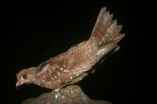(Press-News.org) GAINESVILLE, Fla. --- Conservation of coastal rivers of the northern Gulf of Mexico is vital to the survival of the alligator snapping turtle, including two recently discovered species, University of Florida scientists say.
A new study appearing this week in the journal Zootaxa shows the alligator snapping turtle, the largest freshwater turtle in the Western Hemisphere and previously believed to be one species, is actually three separate species.
The limited distribution of the species, known to weigh as much 200 pounds, could potentially affect the conservation of rivers the turtles inhabit, including the Suwannee, said lead author Travis Thomas, a Florida Fish and Wildlife Commission scientist and former Florida Museum of Natural History volunteer who began the research as a UF wildlife ecology and conservation student.
"We have to be especially careful with our management of the Suwannee River species because this turtle exists only in that river and its tributaries," Thomas said. "If something catastrophic were to occur, such as a chemical spill or something that affects the entire river, it could potentially devastate this species. The turtle is extremely limited by its habitat. All it has is this river and it has nowhere else to go."
In the study, scientists revised the genus Macrochelys, often called the "dinosaurs of the turtle world" by lay people, to include Macrochelys temminkii and the two new species, Macrochelys apalachicolae and Macrochelys suwanniensis. Restricted to river systems that drain into the northern Gulf of Mexico, the species are divided by geography, which led to differences in genetics, said co-author Kenneth Krysko, a herpetologist with the Florida Museum on the UF campus.
"M. temminkii is found in river drainages such as the Mississippi and Mobile, while M. apalachicolae is confined to the Apalachicola and other Panhandle rivers," Krykso said. "There are no alligator snapping turtles in the seven rivers between the Suwannee and Ochlockonee (Aucilla, Econfina, Fenholloway, Saint Marks, Steinhatchee, Wacissa and Wakulla). This gap creates a geographic isolation that has likely resulted in the Suwannee species being the most genetically and morphologically distinct of the three Macrochelys lineages."
These turtles were heavily harvested in the past for human consumption, which decimated populations from Texas to Florida, in part because of the species' low offspring survival rate.
Florida Fish and Wildlife surveys of the Suwannee River during the past three years show M. suwanniensis populations are higher than previously believed. Thomas said the species' survival remains a concern due to its restricted range and Florida law prohibits the possession, capture and pursuit of alligator snapping turtles.
"We hope the new study leads to greater conservation efforts and management plans customized to protect each individual species," Thomas said. "The key to conserving these species is to protect their habitats. If we protect the rivers, that is the biggest step toward protecting the wildlife that depend on them, especially in the case of the Suwannee species."
In the study, researchers examined the fossil record from 15-16 million years ago to the present and found morphological and genetic variations among the three species. Distinct variations were documented in the carapace, or shell, which can be easily observed in both living and fossil specimens.
"The western group (M. temminckii) is morphologically more primitive, but genetics testing suggests that the Suwannee snapper has a deeper divergence," said study co-author Jason Bourque, a vertebrate paleontologist with the Florida Museum of Natural History, "When alligator snappers show up in the fossil record, they look a lot like modern alligator snappers. They do not start showing up in the fossil record until the early Miocene, but snapping turtles as a group go back to the late Cretaceous."
With their spiked shells and scaled bodies, the prehistoric-looking reptiles can live up to nearly 100 years, but it is their amazing size that has drawn peoples' attention for centuries, Thomas said. As large, apex predators, alligator snappers play an important role in the wild. A river ecosystem deprived of its alligator snappers would most likely experience negative implications, Thomas said.
The study's value to conservation biology and other taxonomic studies is invaluable, said John Iverson, a biologist with Earlham College not associated with this research.
"We can finally begin to manage these three genetic units separately and appropriately," Iverson said. "The incredibly detailed work of these researchers in bringing together the genetic, morphological, ecological, zoogeographic and paleontological data to clarify the relationships among the three alligator snapping turtle species should be emulated by other systematists and conservation biologists."
INFORMATION:
Other study co-authors include Kevin Enge, Eric Leone, Paul Moler with Florida Fish and Wildlife Commission; Tony Gamble, University of Minnesota; Michael Granatosky, Duke University; Joe Roman, University of Vermont; and Eric Suarez, UF department of wildlife ecology and conservation.
Writer: Stephenie Livingston, slivingston@flmnh.ufl.edu
Media Contact: Paul Ramey, pramey@flmnh.ufl.edu
Sources: Travis Thomas, 352-334-4221, travis.thomas@myfwc.com
Kenneth Krysko, 352-273-1945, kenneyk@flmnh.ufl.edu
Study shows 'dinosaurs of the turtle world' at risk in Southeast rivers
2014-04-10
ELSE PRESS RELEASES FROM THIS DATE:
How widespread is tax evasion?
2014-04-10
Tax evasion is widely assumed to be an eternal problem for governments — but how widespread is it? For the first time, a new study, co-authored by an MIT professor, has put a cost on a particular kind of tax evasion, known as "round-tripping," that the U.S. government has been trying to thwart.
In round-tripping, U.S. investors move funds to offshore tax havens, then invest in U.S. equity and debt markets with these "foreign" funds. In essence, the U.S. investors are disguising themselves as foreign investors, who are not subject to the same tax rates on capital gains ...
World ranking tracks evoluntionary distinctness of birds
2014-04-10
A team of international scientists, including a trio from Simon Fraser University, has published the world's first ranking of evolutionary distinct birds under threat of extinction. These include a cave-dwelling bird that is so oily it can be used as a lamp and a bird that has claws on its wings and a stomach like a cow.
The research, published today in Current Biology, the shows that Indonesia, Australia and New Zealand all score high on responsibility for preserving irreplaceable species. The researchers examined nearly 10,000 bird species and identified more than 100 ...
Insights into how a bird flu virus spreads could prevent pandemics
2014-04-10
The H5N1 bird flu virus has infected and killed hundreds of people, despite the fact that, at the moment, the virus can't spread easily between people. The death toll could become much worse if the virus became airborne. A study published by Cell Press April 10th in the journal Cell has revealed a minimal set of mutations allowing H5N1 to be transmitted through the air from one ferret to another. The findings will be invaluable for future surveillance programs and may provide early warning signals of the emergence of potential pandemic strains.
"By gaining fundamental ...
Genetic distinctness to guide global bird conservation
2014-04-10
In the midst of today's global extinction crisis, decisions about conservation should include prioritizing how best to preserve as much of the tree of life as possible. So say researchers who report in the Cell Press journal Current Biology on the first application of an approach to identify the most evolutionarily distinct of the world's 9,993 bird species.
At the very top of their list of the most evolutionary distinct birds is the South American oilbird, which represents almost 80 million years of evolution shared with no other bird on the planet.
"Evolutionary distinctness ...
Researchers find that influenza has an Achilles' heel
2014-04-10
Flu epidemics cause up to half a million deaths worldwide each year, and emerging strains continually threaten to spread to humans and cause even deadlier pandemics. A study published by Cell Press on April 10 in the journal Immunity reveals that a drug that inhibits a molecule called prostaglandin E2 (PGE2) increases survival rates in mice infected with a lethal dose of the H1N1 flu virus. The findings pave the way for an urgently needed therapy that is highly effective against the flu virus and potentially other viral infections.
"Drugs that specifically target PGE2 ...
Team solves decades-old mystery of how cells keep from bursting
2014-04-10
LA JOLLA, CA—April 10, 2014—A team led by scientists at The Scripps Research Institute (TSRI) has identified a long-sought protein that facilitates one of the most basic functions of cells: regulating their volume to keep from swelling excessively.
The identification of the protein, dubbed SWELL1, solves a decades-long mystery of cell biology and points to further discoveries about its roles in health and disease—including a serious immune deficiency that appears to result from its improper function.
"Knowing the identity of this protein and its gene opens up a broad ...
Lactate metabolism target halts growth in lung cancer model
2014-04-10
BOSTON – Cancer cells generate energy differently than normal cells, a characteristic that helps them to survive and metastasize. A major goal in the field of cancer metabolism is to find ways to overcome this survival advantage.
Now a research team led by investigators in the Cancer Center at Beth Israel Deaconess Medical Center (BIDMC) has found that targeting the enzyme responsible for the final step of glucose metabolism not only halts tumor growth in non-small-cell lung cancer, but actually leads to the regression of established tumors.
Importantly, the new findings, ...
Getting to the root of Parkinson's disease
2014-04-10
Working with human neurons and fruit flies, researchers at Johns Hopkins have identified and then shut down a biological process that appears to trigger a particular form of Parkinson's disease present in a large number of patients. A report on the study, in the April 10 issue of the journal Cell, could lead to new treatments for this disorder.
"Drugs such as L-dopa can, for a time, manage symptoms of Parkinson's disease, but as the disease worsens, tremors give way to immobility and, in some cases, to dementia. Even with good treatment, the disease marches on," says ...
Too much protein may kill brain cells as Parkinson's progresses
2014-04-10
Scientists may have discovered how the most common genetic cause of Parkinson's disease destroys brain cells and devastates many patients worldwide. The study was partially funded by the National Institutes of Health's National Institute of Neurological Disorders and Stroke (NINDS); the results may help scientists develop new therapies.
"This may be a major discovery for Parkinson's disease patients," said Ted Dawson, M.D., Ph.D., director of the Johns Hopkins University (JHU) Morris K. Udall Center of Excellence for Parkinson's Disease, Baltimore, MD. Dr. Dawson and ...
Researchers determine how mechanical forces affect T-cell recognition and signaling
2014-04-10
T-cells are the body's sentinels, patrolling every corner of the body in search of foreign threats such as bacteria and viruses. Receptor molecules on the T-cells identify invaders by recognizing their specific antigens, helping the T-cells discriminate attackers from the body's own cells. When they recognize a threat, the T-cells signal other parts of the immune system to confront the invader.
These T-cells use a complex process to recognize the foreign pathogens and diseased cells. In a paper published this week in the journal Cell, researchers add a new level of understanding ...


